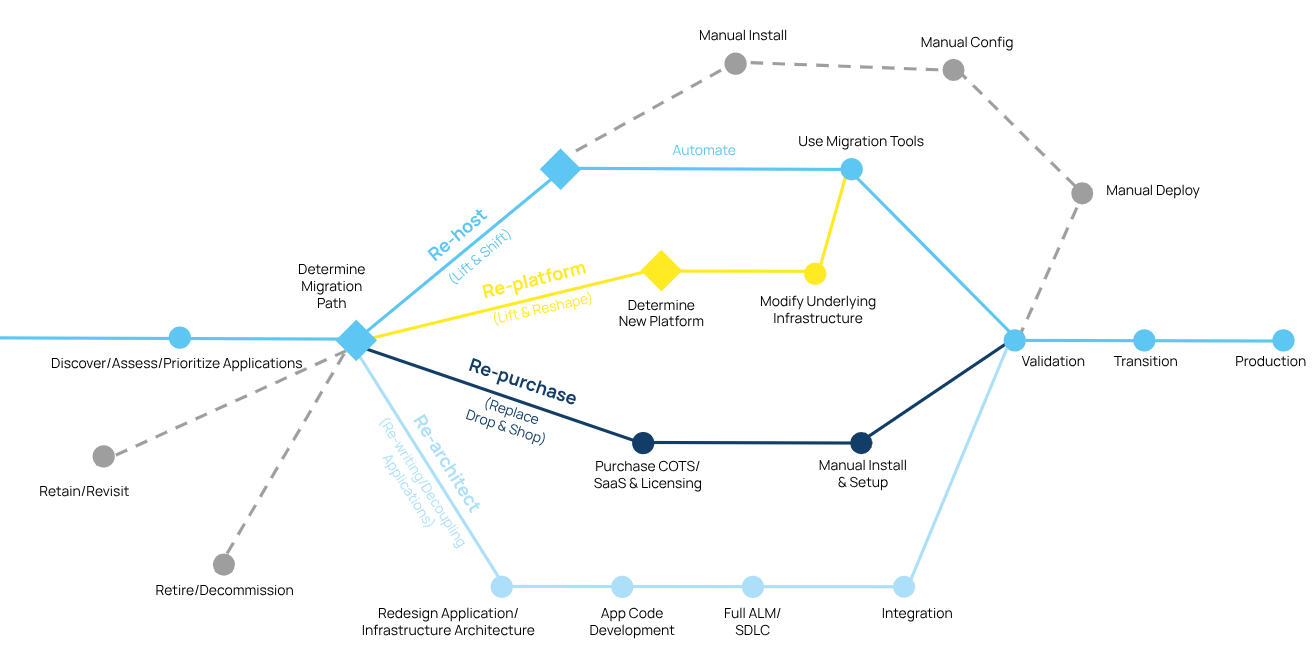Many companies today face significant time and cost pressures when migrating to the cloud. Data center leases are expiring, hardware is outdated, or operating costs are rising rapidly — making a quick Lift & Shift to the cloud seem like an obvious solution. It sounds pragmatic and low-risk. But is it really?
The problem: Migration ≠ Modernization
At first glance, the task seems complete: the systems are running in the cloud, operations continue seemingly without issues. But the true potential of the cloud — scalability, automation, cost efficiency — remains untapped.
Instead, costs often increase, technical debt accumulates, and the IT infrastructure stays just as rigid as before — only now, it’s more expensive. In many cases, Lift & Shift ends up being even more costly than the previous on-premises setup. Why?
- The systems are not optimized for the cloud.
- You pay for resources that are not used efficiently.
- The promised agility fails to materialize.
And therein lies the danger: after a Lift & Shift approach, it is often concluded — “It works.” — without questioning whether the system is truly efficient, scalable, and future-ready.
Why Modernization Is Not an “Optional Feature”
Cloud modernization is not a nice-to-have add-on — it is essential to unlocking the true value of the cloud. It is not just about technical fine-tuning, but about strategic transformation.
Here are just a few reasons why companies must not only migrate, but also modernize:
- The end of VMware: Increasing pressure to act With support for many on-premises solutions ending, there is an urgent need to act. This is an opportunity not just to “move,” but to fundamentally rethink.
Checklist for migrating VMware to AWS
This checklist helps you strategically assess your VMware environment, plan migration paths, and sustainably modernize your infrastructure and applications on AWS.
- Keeping costs under control The cloud can be cost-efficient — if workloads are scaled, automated, and optimized for the environment. Lift & Shift alone does not deliver cost advantages — quite the opposite.
- Addressing the IT talent shortage Automation, self-service platforms, and managed services relieve IT teams that are increasingly required to manage more systems with fewer resources.
- Ensuring future-readiness Only modern, flexible architectures — such as microservices or container-based applications — can meet demands for speed, innovation, and security.
AWS: The structured path to sustainable migration
The good news: modernization does not have to be a mammoth project. AWS offers a structured foundation for decision-making with its 6R migration strategy. Each application is evaluated to determine the right path:
- Rehost (Lift & Shift): Quick and straightforward — for systems requiring minimal changes.
- Replatform: Use of managed services like RDS or SQS without changing the core application.
- Refactor: Deep transformation of the application, e.g., migrating to serverless architectures or containers.
- Retire, Retain, or Repurchase: For applications that can be replaced or are no longer needed.

Important: It’s not an “either-or” decision.
Successful cloud migrations combine these approaches, tailored to business goals, resources, and timelines.
This modernization process does not start with migration — it is continuous and spans all phases:
- Before migration: Analyze and assess all applications — what will be migrated, how, and with what goal.
- During migration: Achieve targeted quick wins. Instead of moving entire applications at once, individual parts or services are gradually moved to the cloud — and modernized right away. Companies gain early insights into cloud operations, reduce complexity in small, manageable steps, and create immediate measurable value.
- After migration: Gradual modernization of individual applications, for example, by introducing CI/CD, Infrastructure as Code, or Zero Trust security.
Before, during, or after cloud migration? — Modernizing at the right time.
Register for the webinar recording to learn how to strategically align modernization with your cloud migration — securing added value, agility, and innovation.
To make this process efficient and sustainable, AWS provides a wide range of powerful tools and best practices:
- AWS CloudFormation / Terraform: For Infrastructure as Code and automated provisioning.
- Amazon EC2 Auto Scaling, Lambda, EKS: For dynamic scaling and flexibility.
- AWS Security Hub, IAM, GuardDuty: For comprehensive security management.
Conclusion: Lift & Shift is only the beginning
Cloud migration is more than just a change of location — it is an opportunity for renewal. Those who stand still pay the price. Those who modernize, win.
A pure Lift & Shift does not automatically make systems more agile, efficient, or future-proof — it simply moves existing problems to a new place. True transformation only begins with conscious, structured modernization.
It can absolutely make strategic sense to start with Lift & Shift — for example, if a data center lease is expiring soon or regulatory requirements demand quick decisions. However, it is crucial that this initial rapid move is not the end, but only the beginning.
Our message: Don’t think of the cloud merely as infrastructure — think of it as an enabler for innovation, efficiency, and sustainable growth. Lift, Replatform, Refactor — with the right combination, you create true cloud value.
